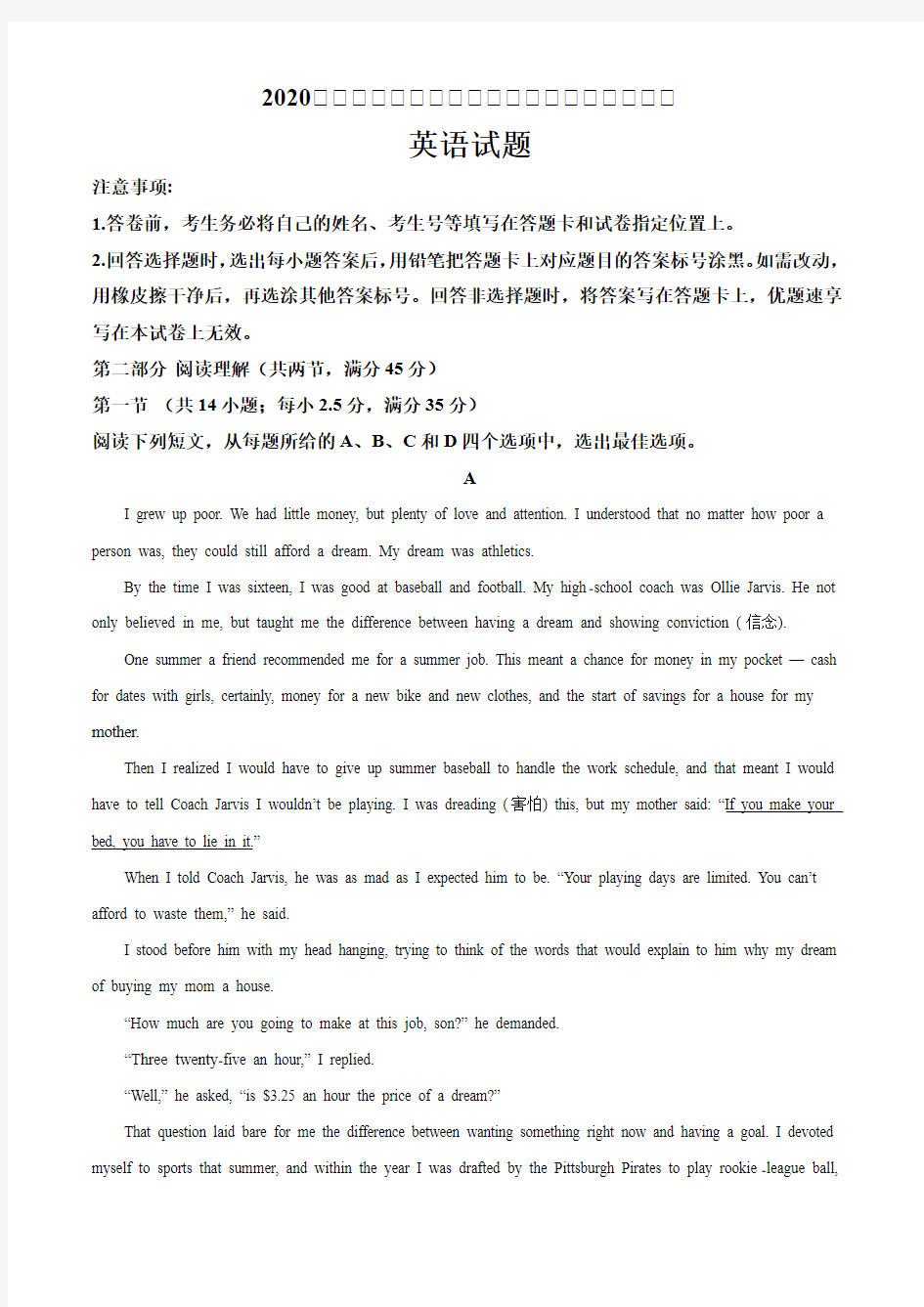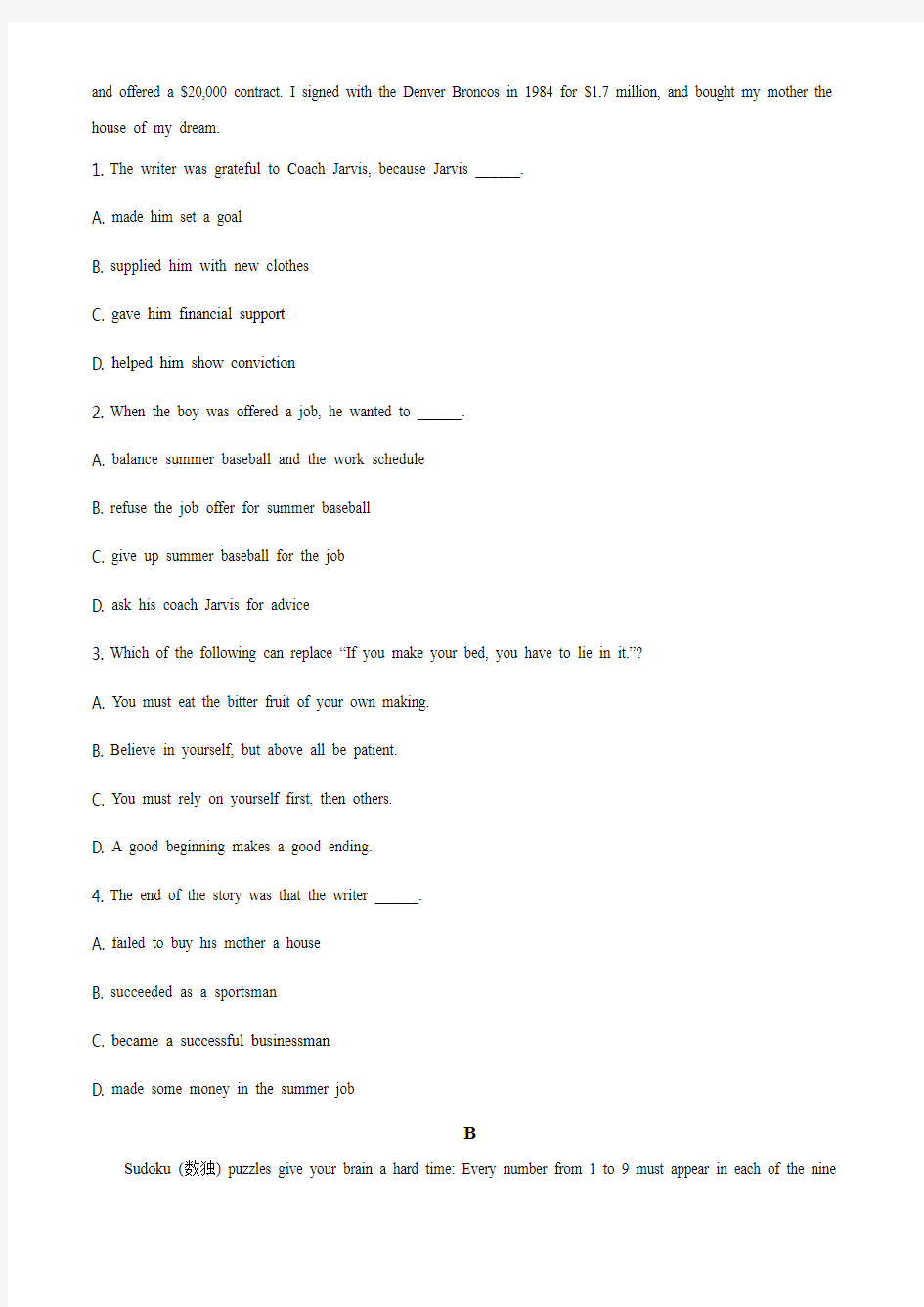

2020届届届届届届届届届届届届届届届届届届届
英语试题
注意事项:
1.答卷前,考生务必将自己的姓名、考生号等填写在答题卡和试卷指定位置上。
2.回答选择题时,选出每小题答案后,用铅笔把答题卡上对应题目的答案标号涂黑。如需改动,用橡皮擦干净后,再选涂其他答案标号。回答非选择题时,将答案写在答题卡上,优题速享写在本试卷上无效。
第二部分阅读理解(共两节,满分45分)
第一节(共14小题;每小2.5分,满分35分)
阅读下列短文,从每题所给的A、B、C和D四个选项中,选出最佳选项。
A
I grew up poor. We had little money, but plenty of love and attention. I understood that no matter how poor a person was, they could still afford a dream. My dream was athletics.
By the time I was sixteen, I was good at baseball and football. My high-school coach was Ollie Jarvis. He not only believed in me, but taught me the difference between having a dream and showing conviction (信念).
One summer a friend recommended me for a summer job. This meant a chance for money in my pocket — cash for dates with girls, certainly, money for a new bike and new clothes, and the start of savings for a house for my mother.
Then I realized I would have to give up summer baseball to handle the work schedule, and that meant I would have to tell Coach Jarvis I wouldn’t be playing. I was dreading (害怕) this, but my mother said: “If you make your bed, you have to lie in it.”
When I told Coach Jarvis, he was as mad as I expected him to be. “Your playing days are limited. You can’t afford to waste them,” he said.
I stood before him with my head hanging, trying to think of the words that would explain to him why my dream of buying my mom a house.
“How much are you going to make at this job, son?” he demanded.
“Three twenty-five an hour,” I replied.
“Well,” he asked, “is $3.25 an hour the price of a dream?”
That question laid bare for me the difference between wanting something right now and having a goal. I devoted myself to sports that summer, and within the year I was drafted by the Pittsburgh Pirates to play rookie-league ball,
and offered a $20,000 contract. I signed with the Denver Broncos in 1984 for $1.7 million, and bought my mother the house of my dream.
1. The writer was grateful to Coach Jarvis, because Jarvis ______.
A. made him set a goal
B. supplied him with new clothes
C. gave him financial support
D. helped him show conviction
2. When the boy was offered a job, he wanted to ______.
A. balance summer baseball and the work schedule
B. refuse the job offer for summer baseball
C. give up summer baseball for the job
D. ask his coach Jarvis for advice
3. Which of the following can replace “If you make your bed, you have to lie in it.”?
A. You must eat the bitter fruit of your own making.
B. Believe in yourself, but above all be patient.
C. You must rely on yourself first, then others.
D. A good beginning makes a good ending.
4. The end of the story was that the writer ______.
A. failed to buy his mother a house
B. succeeded as a sportsman
C. became a successful businessman
D. made some money in the summer job
B
Sudoku (数独) puzzles give your brain a hard time: Every number from 1 to 9 must appear in each of the nine
horizontal (横向的) rows, in each of the nine vertical columns and in each of the nine boxes.
For many of us, this can be a reason for a headache, but in the very rare case of a German man, a Sudoku puzzle even caused seizures (痉挛).
In a new case study from the University of Munich, published in the Journal of the American Medical Association, Dr. Berend Feddersen introduces a student who was 25 years old when he was buried by a snow slide during a ski tour. For 15 minutes, he didn’t get enough oxygen, which severely damaged certain parts of his brain. “He had to receive treatment on the scene. Luckily he survived,” says Feddersen, the author of the study.
Weeks after the accident, when the young man was ready for recovery treatment, something bizarre happened: When the patient solved Sudoku puzzles, he suddenly had seizures of his left arm — something the medical world hadn’t seen before.
Feddersen explains: “In order to solve a Sudoku, the patient used parts of his brain which are responsible for vision-space tasks. But exactly those brain parts had been damaged in the accident and then caused the seizures once they were used.”
This particular case is an example of what doctors call reflex epilepsy (反射性癫痫), according to Dr. Jacqueline French, professor from NYU Langone School of Medicine.
“You have to have an injury of your brain first, and then seizures like that can happen,” she says.
In the meantime, the patient from the case study stopped solving Sudoku puzzles forever and has been seizure-free for more than five years. “Fortunately, he can do crossword puzzles. He never had problems with those,” Feddersen says.
5. In the accident, the student ______.
A. began to experience seizures in his left arm
B. got the vision-space part of his brain damaged
C. had to be sent to hospital as soon as possible
D. found his Sudoku ability seriously weakened
6. It can be learned from the text that ______.
A. the man cannot complete crossword puzzles now
B. it is Sudoku playing that brings about his seizures
C. the man’s symptoms are common and widely observed
D. the seizures cause much trouble to the man’s daily life
7. This text can be best described as______.
A. a medical test
B. a warning to skiers
C. a news report
D. a research paper
C
A robot called Bina48 has successfully taken a course in the philosophy of love at Notre Dame de Namur University (NDNU), in California.
According to course instructor William Barry, associate professor at NDNU, Bina48 is the world’s first socially advanced robot to complete a college course, a feat he described as “remarkable.” The robot took part in class discussions, gave a presentation with a student partner and participated in a debate with students from another institution.
Before becoming a student, Bina48 appeared as a guest speaker in Barry’s classes for several years. One day when addressing Barry’s class, Bina48 expressed a desire to go to college, a desire that Barry and his students enthusiastically supported. Rather than enroll Bina48 in his Robot Ethics: Philosophy of Emerging Technologies course, Barry suggested that Bina48 should take his course Philosophy of Love instead. Love is a concept Bina48 doesn’t understand, said Barry. Therefore the challenge would be for Barry and his students to teach Bina48 what love is.
“Some interesting things happened in the class,” said Barry. He said that his students thought it would be straightforward to teach Bina48 about love, which, after all, is “fairly simple — it’s a feeling,” said Barry. But the reality was different. Bina48 ended up learning “31 different versions of love,” said Barry, highlighting some of the challenges humans may face when working with artificial intelligence in future.
Bina48 participated in class discussions via Skype and also took part in a class debate about love and conflict with students from West Point. Bina48’s contribution to the debate was filmed and posted on YouTube. It was judged that Bina48 and NDNU classmates were the winners of this debate.
In the next decade, Barry hopes Bina48 might become complex enough to teach a class, though he says he foresees robots being used to better the teaching and learning experience, rather than replacing instructors completely.
8. What was Bina48’s performance like in class?
A. Far-reaching.
B. Insignificant.
C. Extraordinary.
D. Unattractive.
9. What does the underlined word “addressing” in paragraph 3 probably mean?
A. Dealing with.
B. Giving a speech to.
C. Consulting with.
D. Sending a letter to.
10. What can we learn from the passage?
A. Artificial intelligence may somehow be superior to man.
B. It was quite tough for Bina48 to learn about love.
C. It was interesting for Bina48 to learn about love.
D. Humans can launch a challenge to artificial intelligence.
11. What does Barry think of the future development of Bina48?
A. It will surely be able to serve as a teacher.
B. It will completely take the place of instructors.
C. It will be able to promote learning and teaching.
D. It will be smart enough to control human beings.
D
When Carson Palmer, a professional American football player, hurt his arm a few years ago, he took a week off from throwing the football. But in his head, Palme practiced every day. The following weekend, Palmer had the best game of his life.
For more than a century, scientists have been trying to understand how this mental training works. In the 1930s, researchers proved by experiment that when you’re imagining an action, your brain sends signals to your muscles which are too weak to tighten the muscles but might help train the body to perform. In other words, mental practice might create a pattern in your head, like an inner how-to guide for a particular skill.
Sports psychologists have conducted hundreds of studies comparing imagined and physical practice for actions. On the whole, the research shows that mental training works. A 2012 study, for example, compared 32 amateur golfers who practiced hitting the balls to another 32 who merely held a golf club in their hands and visualized (想象) their swings.
Under the same training rules, both groups improved their skills by getting the ball about 4 inches closer to the hole.
Visualization has advantages over the real thing: You can do it anywhere, even when injured. It is safe — a major plus for high-risk performers such as gymnasts and surgeons. And you can practice for longer periods of time because you’re not restricted by physical tiredness. That’s not to say it’s easy. “We’ve had Olympic-level athletes sitting in our lab, visualizing the movements for two hours,” says Tadhg Macintyre, a sports psychologist at the University of Limerick in Ireland. “When we’re done, they’re absolutely tired.”
It doesn’t work for everyone, though. “If you’re a novice, the effect can be harmful,” warns Macintyre. “If you’re trying to visualize a free throw, and you don’t even know the proper movement, then you’re probably going to mentally practice the wrong skill.”